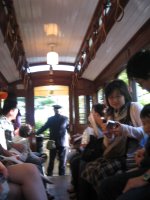Greeting from Japan, where curry is a beloved dish. Different from Thai or Indian curry, and quite tasty to the western palate. Especially to kids! And the curry restaurant has excellent cost performance. Coco is the name of the predominant chain of curry restaurants, where they allow you to personalize your curry rice. A selection of meats on top, different amounts of rice, and spice levels, from 1 to 10. The menu warns that in order to purchase level 6 spice or above, you must first prove that you can take it, by eating a whole serving of level 5.
I pursued this, only because I figured with a chain restaurant the size of Coco, you would need to have a card to register yourself as a Level-5+-spice-approved customer. That card would be a welcome addition to my wallet, and a great souvenier, suitable for framing. Sadly, there appears to be no National Spicy Curry Registration Program. After finishing my Level 5, there was no fanfare or ceremony. And the next time through, I ordered Level 6 and the waiter didn't blink.
In case you're wondering, Level 6 is the point for me where it begins to be work to eat it. It's fine, but it borders on not being enjoyable. So since I forsee there's no T-shirt or badge of honor or placque on the wall when I reach Level 10, I have gone back down to a more comfortable spice level. For Kathleen, the comfortable level is Level 0.
***
Now that we are nearing the end of our stay here (less than 5 months left, don't tell Kathleen), it's time to establish a new and copyrighted feature of this blog. I call it:
Things I'll Miss About Japan
(I need some theme music. Can you do that in a blog? I'll get the staff to work on it.)
First off the top: Chu Hi. I will miss Chu Hi. Everyone who knows about Chu Hi, knows what I'm talking about, and why. For the rest of you, Chu Hi is a mixed beverage with Sho Chu as the alcohol. Sho Chu has the reputation as the poor-man's sake. I think it's Korean in origin. It's a rice or potato based spirit, with about 30% alcohol I think. To make it more drinkable, it's often mixed with fruit juice and soda water to make a Chu-Hi. (Or "Shochu Highball".) The fruit juice is usually citrus. Grapefruit and lemon are the most popular. At a high class bar, they will give you a grapefruit half for you to squeeze your own fresh juice into the drink. At lower class places a syrup is used.
Recently, maybe in the last 10 years, it has become popular as a canned beverage. The good people at Kirin have done wonders with it, though they have for the moment decided not to export it to the US. Plenty of flavors, including pineaple, plum, and Japanese pear.
It's a bit like the Japanese wine cooler, except for one thing: The base alcohol, Sho Chu, is not for kids. The canned Chu Hi product is around 6% alcohol, and tastes like fruity bubbles. A colleague of mine here on business trip was out with friends and called someone after a few Chu Hi to report, "I can't feel my face."
That concludes the first installment of Things I'll Miss About Japan. (Bookend with Exit Music bumper here.) (Fade to black.) (Cue audience applause.)
(Not everything in this ongoing series will be about alcohol. I promise. I really don't drink that much over here. I'm trying to keep my girlish figure.)
***
I'm feeling sporty: How about another new and copyrighted feature! This one is more educational. (I forsee turning it into a useful series of books for the language learner.) The working title is:
Japanese Is Too Hard To Learn!
(So Let's Not Even Try!)
Lesson 1:
There's a word for cute or darling: kawai. Pronounced almost like the Hawaiian island. Easy to remember, right?
Well, be careful, because there's another word. It means scary or frightening. Pronounced: kowai.
It's easy to mispronounce both words sound to sound like "kuh-wai". I'm pronouncing 'kuh' to rhyme with 'duh', and it is very fitting.
I never realized it before, but we as English speakers blur vowel sounds all the time and don't know it. It's how we get all the lovely and different accents in English. It's how you know when someone speaks with a New York accent that they are rude overly biased towards their city, and how when a Kentuckian speaks you know right away he is new to the marvels of indoor plumbing. Very convenient for the listener.
In Japanese, bluring the vowel sounds gets you in big trouble. Be very careful telling the mother of the newborn that the new baby is very cute. You might be calling it scary.
Want another? Think you're ready to progress?
Kirei ('Key-Ray') = beautiful. Kirai ('Key-Rye') = detested or hated.
Gives the old phrase "Don't hate me because I'm beautiful," a new twist. I don't use that phrase all that often. My beauty is way down on the list of reasons I'm hated.
OK, let's close up the new features of the blog and get to what people really want. Pictures.
***
Meiji Mura is an outdoor museum of architechture about an hour outside of Nagoya. When Japan was getting all modern, it was decreed that the primary architectural themes to be embraced would be "Gray" and "Square". To their credit however, someone noticed the trend, and decided to find a way to save important or interesting buildings, and this park was the result. Each building was dismantled, transported, and remantled (?) in this park. It has old street cars from Kyoto, a working steam engine line, the first Christian churches built after the ban on Christianity was lifted, etc. The highlight is the lobby and front exterior fountain from the Tokyo Imperial Hotel, which was a Frank Lloyd Wright work. Enjoy.






 What this prison cell needs some pizazz!
What this prison cell needs some pizazz!
 Veronica checks us in.
Veronica checks us in.




***
If neither animal nor vegetable you be, then mineral you are.
Source: (Japanese Proverb)
***
No comments:
Post a Comment